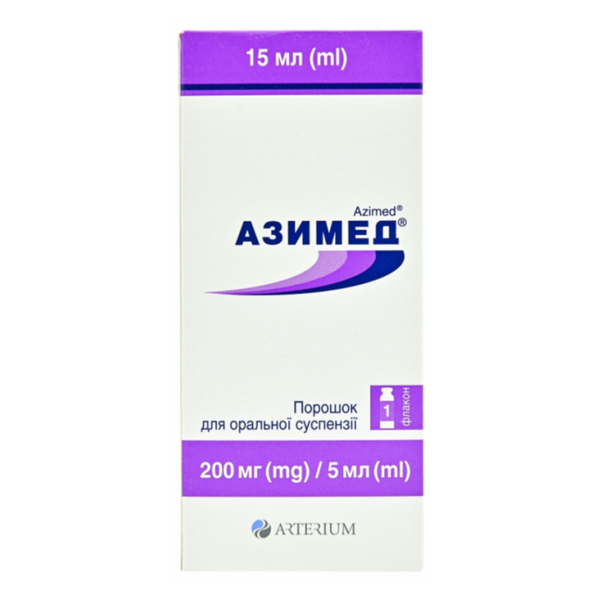|
Quantity
|
Out of stock
|
||
|
|
|||
Composition
Active substance: azithromycin;
5 ml of suspension contains azithromycin dihydrate in terms of azithromycin 200 mg;
Excipients: sucrose, sodium phosphate, hydroxypropyl cellulose, xanthan gum, colloidal anhydrous silicon dioxide, cherry flavoring, banana flavoring, vanilla flavoring.
Contraindication
Hypersensitivity to the active substance, other components of the drug or to other macrolide antibiotics. Given the theoretical possibility of ergotism, azithromycin should not be used simultaneously with ergot derivatives.
Do not use in children weighing up to 15 kg.
Method of application and dosage
Use the drug as a single daily dose at least 1 hour before or 2 hours after a meal. Measure the dose using the oral dosing syringe or spoon included in the package.
Immediately after using the suspension, the child should be given a few sips of liquid to wash away and swallow the rest of the suspension in the oral cavity.
In case of missing 1 dose of the drug, the missed dose should be taken as early as possible, and the next dose should be taken at an interval of 24 hours.
For infections of the ENT organs and respiratory tract, skin and soft tissues (except for chronic migratory erythema), the total dose of azithromycin is 30 mg/kg of body weight (10 mg/kg of body weight once a day). The duration of treatment is 3 days.
Features of application
pregnant
Azithromycin should be prescribed during pregnancy only for vital indications.
Children
Apply to children with a body weight of more than 15 kg. It is recommended to prescribe Azymed®, 100 mg/5 ml to children weighing less than 15 kg.
Drivers
There is no evidence that azithromycin can impair the ability to drive vehicles or work with other mechanisms, but the possibility of side effects such as dizziness, drowsiness, and visual impairment should be taken into account.
Overdose
The experience of clinical use of azithromycin shows that the side effects that develop when taking higher than recommended doses of the drug are similar to those observed when using usual therapeutic doses. They can include diarrhea, nausea, vomiting, reversible hearing loss. In case of overdose, if necessary, it is recommended to take activated charcoal and carry out general symptomatic and supportive medical measures.
Side effects
from the blood and lymphatic system: infrequently - leukopenia, neutropenia, eosinophilia; unknown - thrombocytopenia, hemolytic anemia;
from the side of the psyche: infrequently - nervousness, insomnia; rarely - agitation; unknown - aggressiveness, restlessness, increased psychomotor activity, delirium, hallucinations;
from the side of the nervous system: often - headache; infrequently - dizziness, drowsiness, paresthesia, dysgeusia; unknown - fainting, convulsions, anosmia, parosmia, ageusia, myasthenia gravis, hypoesthesia;
from the organs of vision: often - visual disturbances;
from the organs of hearing: infrequently - hearing impairment, vertigo; unknown - impairment of hearing, including deafness and / or ringing in the ears;
from the side of the heart: infrequently - palpitations; unknown - flutter-flicker (torsade de pointes), arrhythmia, including ventricular tachycardia (they were also found to be caused by other macrolide antibiotics), prolongation of the QT interval on the ECG;
from the side of vessels: infrequently - hot flashes; unknown - arterial hypotension;
on the part of the respiratory system: infrequently - dyspnoea, epistaxis, impaired respiratory function, rhinitis;
from the side of the digestive tract: very often - diarrhea; often - nausea, vomiting, abdominal discomfort (pain / spasms); infrequently - gastritis, flatulence, dyspepsia, dysphagia, dry mouth, belching, ulcers in the oral cavity, hypersecretion of saliva, anorexia, constipation; unknown - change in color of the tongue, pancreatitis;
Interaction
Azithromycin should be prescribed with caution simultaneously with other drugs that can prolong the QT interval.
Antacids. With the simultaneous use of antacids, in general, there are no changes in the bioavailability of the drug, although the peak plasma concentrations of azithromycin are reduced by 30%. Azithromycin should be taken at least 1 hour before or 2 hours after taking an antacid.
Cetirizine. In healthy volunteers, during the simultaneous use of azithromycin for 5 days with cetirizine 20 mg in the steady state, no phenomena of pharmacokinetic interaction or significant changes in the QT interval were observed.
Didanosine With the simultaneous use of daily doses of 1200 mg of azithromycin with didanosine, there was no effect on the pharmacokinetics of didanosine compared to placebo.
Digoxin. Concomitant use of macrolide antibiotics, including azithromycin, and P-glycoprotein substrates such as digoxin has been reported to result in increased serum P-glycoprotein substrate levels. Therefore, with the simultaneous use of azithromycin and digoxin, it is necessary to take into account the possibility of an increase in the concentration of digoxin in the blood serum.
Zidovudine. Single doses of 1000 mg and 1200 mg or multiple doses of 600 mg of azithromycin had no effect on plasma pharmacokinetics or urinary excretion.
dovudine or its glucuronic metabolites. However, taking azithromycin increased the concentration of phosphorylated zidovudine, a clinically active metabolite, in mononuclear cells in the peripheral circulation. The clinical relevance of these data is unclear, but may be useful for patients.
Rizhkiv Given the theoretical possibility of ergotism, simultaneous administration of azithromycin with ergot derivatives is not recommended.
Azithromycin has no significant interaction with the hepatic cytochrome P450 system. It is believed that the drug does not have a pharmacokinetic drug interaction, which is observed with erythromycin and other macrolides. Azithromycin does not induce or inactivate cytochrome P450 through the cytochrome-metabolite complex.
Pharmacokinetic studies of the use of azithromycin and the following drugs were conducted, the metabolism of which takes place to a large extent with the participation of cytochrome P450.
Atorvastatin. Simultaneous use of atorvastatin (10 mg per day) and azithromycin (500 mg per day) did not cause changes in the concentrations of atorvastatin in blood plasma (based on the analysis of HMG-CoA reductase inhibition).
Carbamazepine. In a pharmacokinetic interaction study in healthy volunteers, azithromycin did not show a significant effect on plasma levels of carbamazepine or its active metabolites.
Cimetidine. In a pharmacokinetic study of the effect of a single dose of cimetidine on the pharmacokinetics of azithromycin taken 2 hours before taking azithromycin, no changes in the pharmacokinetics of azithromycin were observed.
Storage conditions
Store in the original packaging at a temperature not higher than 25 °C.
Store the prepared suspension in the original packaging at a temperature not higher than 25 °C.
Keep out of the reach of children.
Shelf life - 2 years.
The shelf life of the finished suspension is 10 days.
































